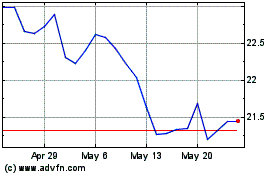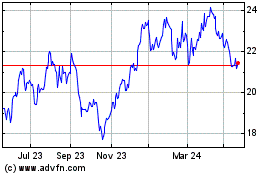UPDATE: Fortescue Metals Shipments Increase, But Forex Pressures Margins
January 17 2011 - 10:12PM
Dow Jones News
Iron ore shipments by Fortescue Metals Group Ltd. (FMG.AU)
increased by 12.6% on year in the quarter ended Dec. 31 to 10.6
million metric tons, but the stronger Australian dollar kept up the
pressure on the miner's margins despite a 20% rise in its selling
prices.
The world's fourth-largest iron ore miner said its average
selling price was US$150 per dry metric ton, including cost and
freight at end-user ports, compared to US$125/ton in the previous
quarter.
Cash costs rose an identical 20% on the quarter to US$41.50/ton,
Fortescue said in its second-quarter production report.
Chief Financial Officer Stephen Pearce said US$3 of the US$6.67
increase in cash costs was down to the rise in the Australian
dollar, which rose 7.3% against the U.S. dollar from an average
91.5 U.S. cents to 98.8 cents over the quarter.
"The December quarter costs were clearly higher than we would
like and higher than our target levels," he said, although the
increase in prices was offsetting the impact of the rises. In both
quarters, the margin of sales prices above cash costs came to
72%.
Management said rainfall slowed some of the company's
construction activities and caused three iron ore cargoes carrying
a total 500,000 tons of ore to be deferred to the current
quarter.
A tropical cyclone bearing down on Australia's northwest coast
on New Year's Day caused the temporary closure of the Pilbara iron
ore region's two major bulk ports.
However, executive director Russell Scrimshaw said a backdrop of
rising iron ore prices left the company optimistic about its
prospects.
"The market is strong, demand is strong. I'd love to be able to
produce more but we're buoyant about the medium term," he said.
Fortescue expects to mine 40 million tons a year from its
Christmas Creek and Cloudbreak mines and is planning an US$8.4
billion expansion to 155 million tons a year of production in 2014,
which would put it on a par with the current output of Rio Tinto
PLC (RIO) and BHP Billiton Ltd. (BHP), the world's second and
third-biggest iron ore miners behind Brazil's Vale SA (VALE).
Fortescue's own share of ore shipped, excluding third-party
shipments, rose 9.4% on the year to 9.9 million tons, the miner
said, while the overburden removed to access ore bodies increased
50% to 39.5 million tons.
The miner's production was well ahead of the previous year but
slipped back from the record September quarter, when 11.1 million
tons of ore was mined and 10.1 million tons of Fortescue's
production was shipped.
The miner said it had sold a trial shipment to an Australian
steelmaker, understood to be BlueScope Steel Ltd. (BSL.AU) as the
only other steelmaker, OneSteel Ltd. (OST.AU), mines its own iron
ore.
"The initial sale was a trial shipment but we expect we will
have a continuing long-term relationship with that customer," said
Scrimshaw.
Fortescue said cash on hand increased by US$1 billion during the
quarter to US$2.37 billion. Two bond issues over the December
quarter raised US$3.54 billion in capital, although $2.04 billion
of that total was replacing an existing debt facility which was
repaid.
Australia's Bureau of Meteorology is predicting a
heavier-than-usual cyclone season in the Pilbara, with 11 or 12
storms expected before the cyclone season ends in April, of which
only two have formed so far.
Paul Hallam, director of operations, said the company hopes it
has been spared the impact of the weather. "We've got our fingers
crossed," he said. "We have been fortunate in not being impacted by
any major events since we started production."
The company said it wasn't worried by the impact of flooding in
Australia's Queensland state, which has caused disruptions to the
state's exports of hard coking coal that some analysts expect to
double the price of the commodity to US$400/ton or more.
That could have knock-on effects for iron ore demand, as the
tighter margins for steelmakers who use hard coking coal may cause
them to trim production, and thus iron ore purchases.
"We've already scheduled our shipments over the next few months
and the (iron ore) price has continued to adjust (upwards) over the
last few weeks while this bad weather has hit coking coal states,"
said Scrimshaw. "We think our book's pretty well covered."
Management also said they were unconcerned about moves by China
to raise interest rates, as they were only likely to affect
smaller, less profitable steel mills.
"There's probably more than 800 steel mills in China," said
Scrimshaw. "The largest 50 or so are our customers, and yes there
is consolidation going on (but) we're not concerned. We'd love to
have more stock to sell if we could," he said.
-By David Fickling, Dow Jones Newswires; +61 2 8272 4689;
david.fickling@dowjones.com
Bluescope Steel (ASX:BSL)
Historical Stock Chart
From Apr 2024 to May 2024

Bluescope Steel (ASX:BSL)
Historical Stock Chart
From May 2023 to May 2024
